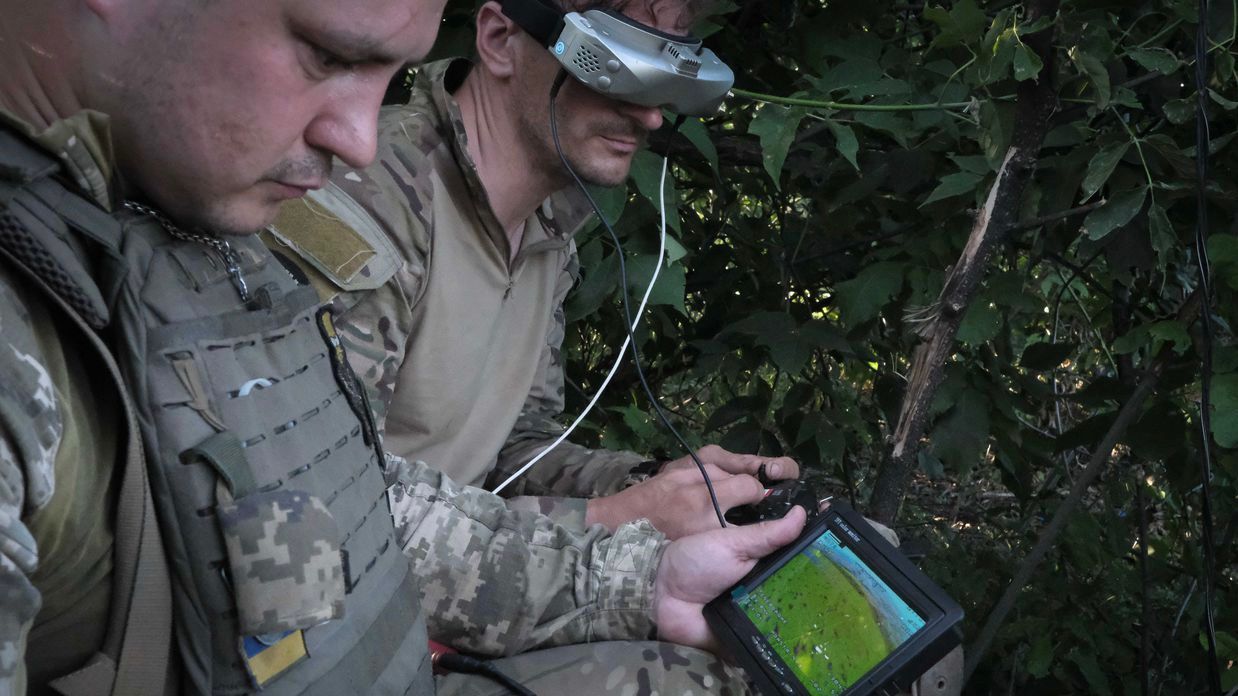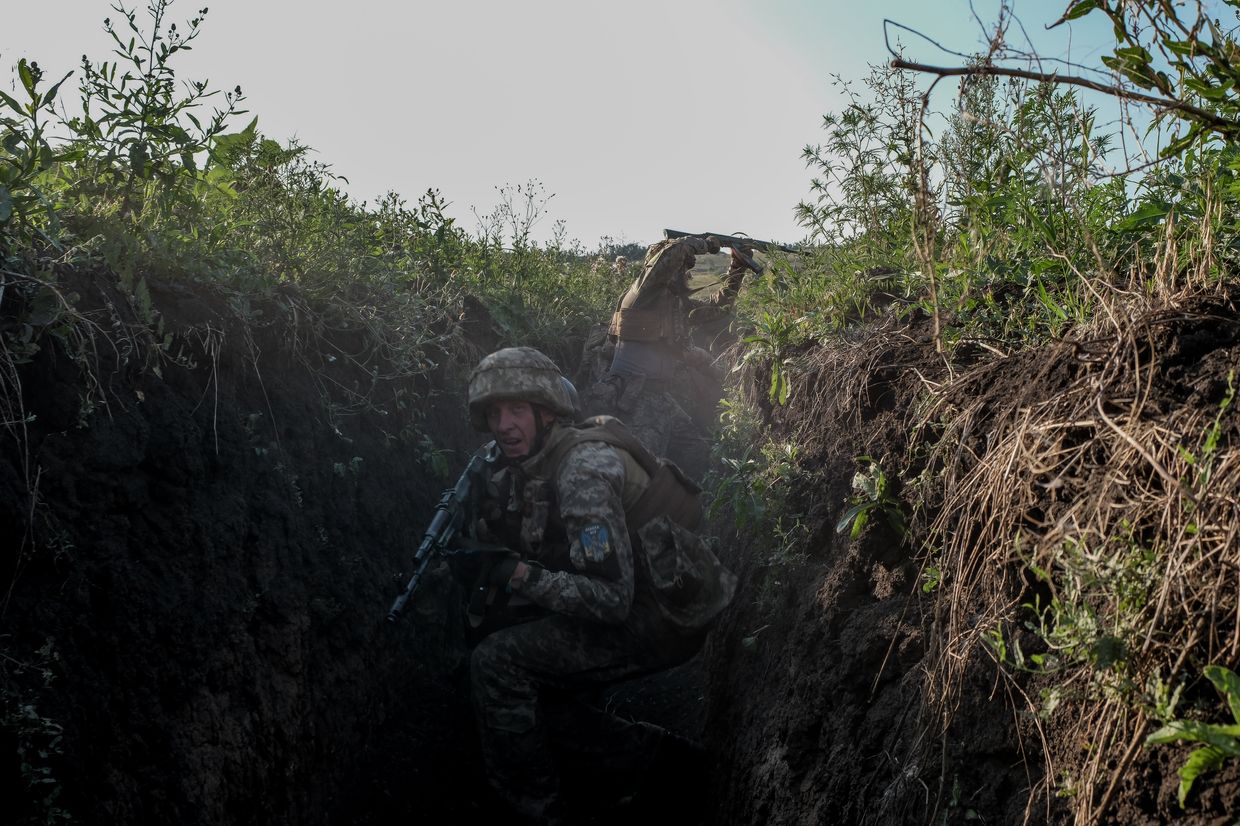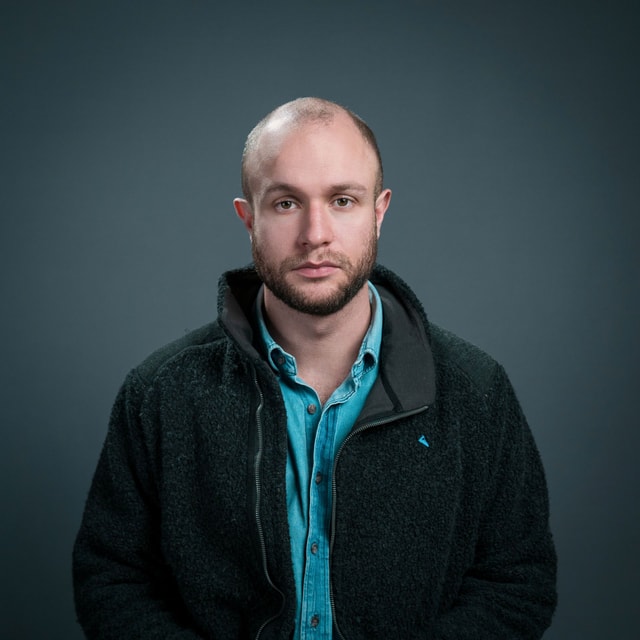Overcoming setbacks, NATO-trained brigade breaches Surovikin line in Zaporizhzhia Oblast

Editor’s note: The soldiers featured in this article are identified by first name and callsign only for security reasons.
ZAPORIZHZHIA OBLAST – Even months before it started, just the idea of Ukraine’s large-scale counteroffensive in 2023 carried on its shoulders a historic weight.
Having held back waves of brutal Russian ground attacks over winter, this was Kyiv’s chance to not only regain the initiative but to put the war on a decisive trajectory towards Ukrainian victory, breaking the Russian military, liberating vast areas of its territories, and threatening Russia’s presence in Crimea.
The months of anticipation over spring only raised the stakes. While Ukrainian brigades trained abroad and Western tanks slowly trickled in, Russia was digging formidable lines of defensive structures in the south, visible to the world on satellite imagery.
When the time finally came to move forward, much of this weight of expectation lay on the shoulders of just one brigade. The 47th Mechanized Brigade, held up as a progressive model of the Ukrainian army of the future, was to lead the push south of Orikhiv, heading straight for the key cities of Tokmak and Melitopol.
Formed from scratch a year ago, the brigade often known by the name “Magura," was prepared with the counteroffensive in mind; its soldiers, trained in NATO countries and equipped with superior new Western equipment, were to be the spearhead of the advance here.
“They invited people (to the brigade) who knew why they want to be here, for what, for whom, which goals,” said Oleksandr “Hollywood,” a Kyiv native who once worked in filmmaking but now serves in the 47th; “not just in a military sense of following orders, but on the level of liberating our country.”
For three and a half months, the world’s eyes have been on the handful of villages and the fields surrounding them south of Orikhiv. Of all the areas where Ukrainian forces have advanced, this one is the most consequential, and the best defended.
Since the counteroffensive was launched in June, the story of the Orikhiv axis has been the story of the 47th, with ups and downs, moments of immense pride and inevitable regret.
Looking at the map, progress has been painfully slow, fuelling an endless cycle of discussion in the media about if and when the counteroffensive can be judged to have failed.
The map alone doesn’t in any way do justice to what Ukrainian forces have faced: dense minefields in front of multiple fortified defensive lines, all backed by massed Russian artillery fire and airpower.
After a long period of attritional fighting and plenty of criticsm, the 47th along with other units finally made fresh advances.
Liberating the village of Robotyne in late August, Ukrainian forces have now reached and breached the main Russian line of defense, known as the Surovikin line after the former overall commander of Russia’s war against Ukraine.
As the war races through its second autumn, the clock looks to be ticking on the counteroffensive and Ukraine’s chances to claim success in this bloody, costly push.
In their bases near the front line, the Kyiv Independent spoke to soldiers of the 47th, reflecting on a tumultuous summer campaign, fighting at the tip of the spear, and the road ahead.

Into the deep end
Over 19 months of Russia’s full-scale war, many of Ukraine’s dozens of combat brigades have made a name for themselves through deeds on the battlefield, with some, like the Third Assault Brigade fighting near Bakhmut, taking it further to build a distinct identity and brand around their unit.
With the 47th Mechanized, it was the other way around: the brigade was built from scratch around its own unique brand, before ever seeing any combat.
The central architect of this new brigade was Valerii Markus, a 30-year-old sergeant in what was then the 47th Separate Rifle Battalion, who was invited in October 2022 by Commander-in-Chief Valerii Zaluzhnyi to form the brigade together with battalion commander Ivan Shamalaha.
Leveraging his well-known personal brand as a young, progressive face of the Ukrainian military, Markus attracted a new wave of volunteer soldiers at a time when most who had wanted to fight had enlisted long before.
“When the brigade was first formed and I heard about it, I was interested straight away, by its culture, its modern approaches,” said 33-year-old assault soldier Vyacheslav "Arkush," to the Kyiv Independent.

“They had a public image as a place where you don't just fight in the classic sense, but do with your head, with ideals, with modern technology and people, intelligent people, entrepreneurs.”
“It wasn’t about right or left ideology,” added Maksym, a sergeant in the same anti-air unit as Oleksandr. “It's just about good, capable, dignified people.”
The assault troops interviewed had undergone training in several different NATO countries, including Germany, Slovakia, and Latvia, where Vyacheslav trained over winter.
“The Latvians were great instructors,” he said, “they took us step by step, from basic awareness of what war is to using weapons, grenades, I really liked the program, it was always interesting.”
Other reviews of the NATO training were more mixed, backing up a documented tendency that the courses did not adequately prepare soldiers for Ukrainian trench warfare, without air superiority.
“What I didn't like about the training, is that the Americans have no idea what the war is like here,” said Oleksandr. “They give us exercises to climb to the top of a building, shoot down a helicopter with a Stinger, and abseil back down on ropes.”
“We told them, 'Are you out of your mind? Any buildings will be demolished by tanks and air-dropped bombs as soon as we enter.'"
Despite lacking combat experience and with serious shortcomings in the training, the 47th, equipped with Bradleys and Leopard 2 tanks, was assigned one of the most unenviable tasks of the war so far: a front-on attack in Zaporizhzhia Oblast, where Russian defensive lines were most concentrated.
It didn’t go well at first. In what looked like a suicidal armored assault against the first minefields, Russian media quickly relished in grim drone footage of destroyed Leopards and Bradleys.
“Our problem was that we hadn't been shot up (didn't have combat experience), they threw us into battle, and it was hell,” said Oleksandr.
The lost armor only amounted to a company-sized attack, but Russia had won a major propaganda victory, made worse by the failure to take significant territory in the weeks following.
Ukraine watched closely as the early setbacks mounted, with horrifying drone footage of soldiers and equipment from the brigade blown up by landmines spreading quickly online.

With scrutiny building, Markus spoke out on social media, publicly accusing the 47th’s officer corps of incompetence, and adding that the senior command was guilty of "not understanding of the importance of the morale of soldiers."
The command hit back, with Sergeant-Major Rustam Mustafaiev accusing Markus of "trying to promote himself on the back of other people's blood and other people's work." Markus resigned from his post on June 11, less than a week into the counteroffensive.
June and July passed without much more movement on the axis. Reflecting on their mistakes, the 47th Brigade spent the time preparing better plans while continuing to attrit Russian forces from afar.
“I arrived right when we started to make conclusions, analyze what had gone wrong, and start to change things,” said Vyacheslav, who began his service after the initial attacks. “By then we had gained a second wind.”
By mid-August, the brigade was on the move again, and this time, began making real gains. With three months of hard fighting under its belt, the unit is now no longer the green outfit that had arrived on the battlefield in June.
“Now, our brigade has been shot up plenty,” Oleksandr noted with a dry laugh.

Pounding through
Burnt-out buildings and piles of rubble on every corner mark Orikhiv as another Ukrainian city in which — bar some soldiers ducking in and out of basements and the odd oblivious civilian roaming the streets — no human life remains.
Since Ukraine launched its counteroffensive push here in June, Russia has tasked itself with the systematic destruction of the city with a new favorite weapon: guided air-dropped bombs.
Under clear afternoon skies, Russia’s liberal use of the bombs is on proud display. On the horizon to the east, miniature mushroom clouds rise from successive strikes on Ukrainian positions near the village of Verbove. Inside Orikhiv, another bomb lands behind some houses just over a kilometer away, while fire rages from the ruins of a house recently flattened by yet another.
Just 10 kilometers away, in some of the heaviest fighting of the summer campaign, assault units of the 47th inch forward, storming Russian trenches one by one before being rotated out by regular infantry.
The capture of Robotyne in late August, the first and so far only village liberated on the Orikhiv axis, provided Ukraine with new hope of success after a long period without advances. When the time came to take the village itself, it didn’t take long.
“At first, our task was to work to capture the positions just outside Robotyne,” said Vyacheslav “but when we met the commander to make the plan of attack, he said that plans have changed, because our guys had already advanced into the village itself, so we will move into the first houses.”
“On our way in, we got a call from the battalion commander, he said that we've gone further so the plans changed again, and in the space of a day, we moved forward more than two kilometers.”
Beyond Robotyne, Ukrainian forces have now come up against a new obstacle: the Surovikin line itself, the backbone of a vast network of defenses built by Russia over winter and spring across the entire southern front line.
Until now, the line was seen only from above, but according to the assault troops, the most impressive part of it lies dug deep into the Ukrainian earth.
“They are usually 2-3 meters deep, reinforced with wood and earth,” said assault commander Yaroslav “Ram,” 44. “From the drones you only see a couple of trenches, but you can't see what is under it.”
“Until you go in there on your own two feet and see with your own eyes, everything looks the same from the sky.”
As difficult as it is to assault Russia’s underground labyrinths, the fight above ground is no less perilous.
As an anti-air unit, Oleksandr’s squad is normally equipped with shoulder-launched Igla anti-air missiles, but according to them, this old, heavy weapon is unreliable, bordering on useless.
For today’s war, their gun of choice fires no projectile: a lightweight, Lithuanian-made anti-drone device that jams enemy drones.
Both sides have dramatically scaled up the production of FPV (first-person view) drones in recent months, while also refining their use on the battlefield.
According to Maksym, while the artillery duel in the area is evenly matched, Russia has the edge in FPV drones, often using them to strike not only vehicles and artillery, but small groups of individual soldiers.
The consequences of this new face of war is felt keenly by soldiers more used to the random lottery of indirect artillery fire.
“Our enemy has learned and adapted,” he said.
“Now, having already started the artillery bombardment, they fly out with FPV drones because they know that we won't have our heads up with the anti-drone gun. And with these drones they try to fly right into our dugout.”
Lifesaving ‘taxis’
Futher along the treeline in the rear where the assault troops are staying, two bulky green machines are also resting between the bushes.
Their shape immediately gives away that they aren’t Soviet-era vehicles. These are the M2 Bradleys themselves, a mainstay of the U.S. Army since the 1980s and now entrusted to the 47th Brigade.
Their rear doors are open, showing a roomy interior that comfortably fits six soldiers sitting opposite each other.
“You can fit 10 in there easily if you really need to,” quipped 38-year-old Bradley driver Oleksandr “Kipish,” looking fondly at his vehicle.
A truck driver before the full-scale war, Oleksandr spent six weeks in Germany specifically to train on the Bradley.
On the battlefield, the vehicles are prized for their survivability, with armor technology far superior than their Soviet counterparts. All the assault troops here have their own Bradley stories, of the vehicles evacuating them from missions, driving over multiple mines without the passengers even noticing.
This particular vehicle had visible scars from what Oleksandr said was a near-direct 120mm mortar hit.
“Take a Soviet BMP, for example,” he said, “if you had a hit in the back like here, nobody inside would be alive.”
“They are great machines, they save people every day.”
Early on in the counteroffensive, the 47th’s early setbacks were proudly paraded by Russian state media and Telegram channels, with one drone capture showing eight disabled Bradleys and a Leopard tank side by side in a row.
“Everyone survived that attack,” claimed Yaroslav, “and every last vehicle was successfully retrieved.”
As good as they are at saving lives, the density of Russian fires combined with real-time drone reconnaissance in the area makes using them a risky act.
“We mostly work like a taxi, we bring the guys in and bring them out,” said Oleksandr.
“We don't use it on assaults much, only if we get a special order, it's dangerous. We actually had an assault yesterday with two Bradleys, and both were hit with anti-tank fire. Everyone survived.”
History-makers
On Sept. 23, Oleksandr Tarnavskyi, commander of Ukrainian operations on the southern front line, reported that Ukrainian troops had broken through the line a second time, further east near Verbove.
It’s clear by now, though, that a “breakthough” here will be nothing like the breakthrough achieved in Kharkiv Oblast a year ago, when Ukrainian forces routed Russian lines and liberated swathes of territory in a matter of days.
Experts agree that the Surovikin line was built with a typical defense in depth strategy in mind, designed to inflict maximum attrition to the attacker, while preventing a tactical breach from turning into a strategic breakthrough like what Ukraine achieved in Kharkiv Oblast.
Though the Russian command’s management of its defensive lines has been criticized as going against Surovikin’s original strategy, the Ukrainians tasked with assaulting them speak with respect for the way Russian troops have dug in.
“I'll say it now,” Oleksandr said, “the Russians are the best in the world when it comes to building fortified defenses; minefields, strongholds, they know this very well.”
Having passed the minefields and made a successful breach, Yaroslav is hopeful that more is yet to come.
“At the moment, we have created the biggest breach here,” he said. “We have gotten past the toughest part, now the job is to widen the breach. It should be a lot easier going forward, thank God there aren't as many mines.”
Even if the Surovikin line is completely broken through, the road ahead is long.
The strategic city of Tokmak, widely understood to be the main goal of this axis of the counteroffensive, is still another 20 kilometers south of the Robotyne bulge, and is itself defended by its own ring of Russian fortifications.
Reaching the city before winter looks increasingly unlikely, but the lessons of the offensive’s first weeks laid bare the price of haste.
“We just can't do it any faster,” said Yaroslav. “We've simply been exhausted a fair bit by three and a half months of fighting, sometimes when you take a break you just sleep for three days straight.”
When asked about the looming winter, soldiers acknowledged that the fighting will assume a different character, but that it doesn’t mean that the Ukrainian initiative must stop dead in its tracks.
Setbacks suffered and lessons learned aside, soldiers of the 47th Brigade remain acutely aware of the fateful character of their mission.
“We were told that either we will go down in history, or we will be forgotten, because we are here at the tip of the spear, we were to be sent into one of the toughest fights that this war could possibly offer,” said Yaroslav.
“And that's how it turned out."
The Kyiv Independent is grateful to our members and donors. This story wouldn't have been possible without a donation from The Charles Douglas-Home Memorial Trust.
Note from the author:
Hi, this is Francis Farrell, cheers for reading this article. I grew up on the other side of the world, but in Ukraine I have found a home unlike any other. Just like with so many of our readers, I understand that you don't have to be from near here to realize how important Ukraine's struggle is for freedom and human rights all over the world. The Kyiv Independent's mission is to lead the way in continuing to bring the best homegrown, English-language coverage of this war, even if the rest of the world's attention starts to fade. Please consider supporting our reporting.






















